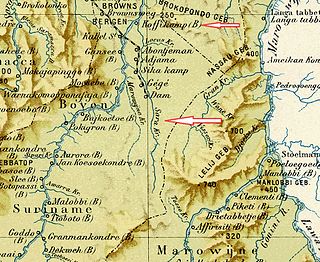
Sipaliwini is the largest district of Suriname, located in the south. Sipaliwini is the only district that does not have a regional capital, as it is directly administered by the national government in Paramaribo.

Kajana is a village in Sipaliwini District, Suriname. It lies on the Gaan-lio, which together with the Pikin Lio forms the Suriname River. The population call themselves Kadosi-nengre after Cardoso who was the owner of the plantation they ran away from. The village is home to Maroons of the Saramaka tribe.
Abenaston is a village on the Upper Suriname River in Suriname with a population of about 700 people in 2005. The population consists of Saramaka Maroons.

Aurora is a town in the Sipaliwini District of Suriname on the Upper Suriname River. Aurora is a tribal village, and has a twin village called Nieuw Aurora which was built as an extension. The village is home to Maroons of the Saramaka tribe.

Botopasi, also spelled Boto-Pasi, is a Saamaka village in Suriname. The village had a population of about 740 people in 2001.
Goddo is a small village in Suriname. The village sits on the Upper Suriname River, 1.81 kilometres north of the Pikin River. Goddo can be reached via the Djumu Airstrip, or by boat from Pokigron. The village is home to Maroons of the Saramaka tribe.

Pokigron is a town in Suriname located on the Upper Suriname River near the Brokopondo Reservoir. It is located in the Boven Suriname municipality (resort) in the Sipaliwini District. It has a population of approximately 400 people in 2018. Pokigron is located at the end of a paved road via Brownsweg to the Afobakaweg. Pokigron is often referred to as Atjoni which is the nearby quay, and literally the end of the road. Villages to the South of Pokigron have to be accessed by boat. The village is home to Maroons of the Saramaka tribe.
Wanze Eduards is a Saramaka leader from the Republic of Suriname for the village of Pikin Slee. During the 1990s logging companies encroached on the village of Pikin Santi. Extensive flooding caused by faulty bridging resulted in the loss of large plots of agricultural land.

Boven Suriname is a resort in Suriname, located in the Sipaliwini District. Its population at the 2012 census was 17,954. Almost its entire population consists of Maroons
Hugo Jabini is a Saramaka Maroon politician and environmental leader from Suriname. In 1998 he became the spokesman of the Association of Saamaka Authorities. In 2007 he and Wanze Eduards were part of the VSG team that won an landrights lawsuit against the Surinamese government in international court. For their work in the landrights struggle they shared the Goldman Environmental Prize in 2009. From 2010 to 2015 Jabini was a member of the Surinamese National Assembly, as part of the National Democratic Party (NDP).
Belfon Aboikoni was granman of the Saramaka maroons in Suriname. Aboikoni was sworn in as chief of the Saramaka, one of Suriname's Maroon peoples, in October 2005 at the age of 65. He succeeded the late chief Songo Aboikoni who died two years earlier. Belfon Aboikoni focused on land rights during his time as chief.
Medische Zending Primary Health Care Suriname, commonly known as Medische Zending or MZ is a Surinamese charitable organization offering primary healthcare to remote villages in the interior of Suriname.

The Matawai are a tribe of Surinamese Maroons. The Matawai were originally part of the Saramaka, and signed a peace agreement with the Dutch colonists in 1762. The tribe split from the Saramaka, and in 1769, they were recognized as a separate tribe.

Paramacca is a resort in Suriname, located in the Sipaliwini District. The population is estimated between 1,500 and 2,000 people. In 1983, the Sipaliwini District was created, and the eastern part became the resort of Tapanahony. The Paramacca resort is the northern part of Tapanahony, and mainly inhabited by the Paramaccan people, the border of the resorts is the island of Bofoo Tabiki in the Marowijne River.
Jaw Jaw, also Yaw Yaw, is a village of Saamaka Maroons in the Boven Suriname resort of the Sipaliwini District of Suriname. The village is located on the Suriname River.
Pikin Saron is an indigenous village of Kalina Amerindians in the resort of Zuid in the Para District in Suriname. The village can be accessed from the Southern East-West Link, and is located on the Saramacca River.

Sara Creek is a former tributary of the Suriname River located in the Para District of Suriname. After the completion of the Afobaka Dam in 1964, the Sara Creek flows into the Brokopondo Reservoir. In 1876, gold was discovered along the Sara Creek, and a railway line from Paramaribo to the river was completed in 1911.

The Upper Suriname River is the upper reach of the Suriname River. Shortly before the transition to the Lower Suriname River, there is the Brokopondo Reservoir. From there, the access by road ends at the jetty of Atjoni, near Pokigron. The Suriname River begins at the confluence of the Gran Rio and Pikin Rio near the village of Goddo with the Tapawatrasula rapids.











